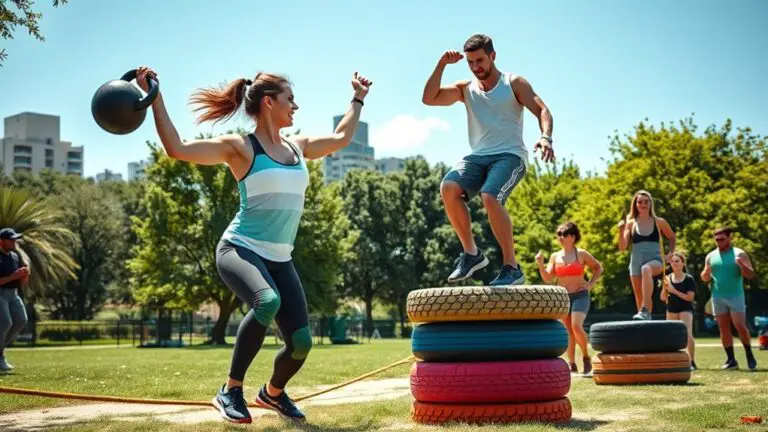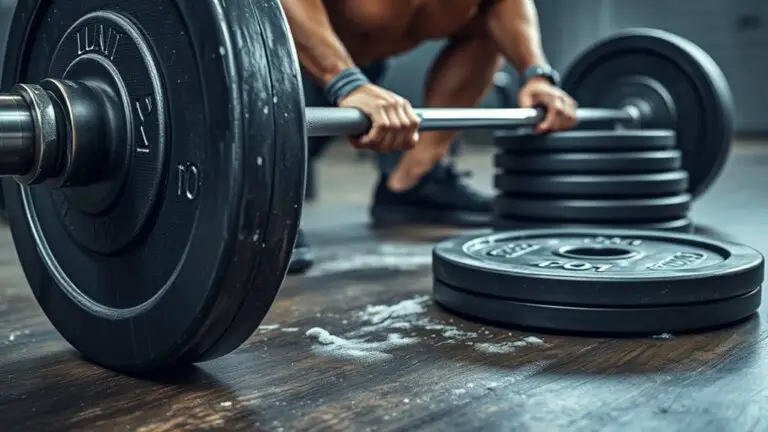How to Train for Explosive Power as a Basketball Player
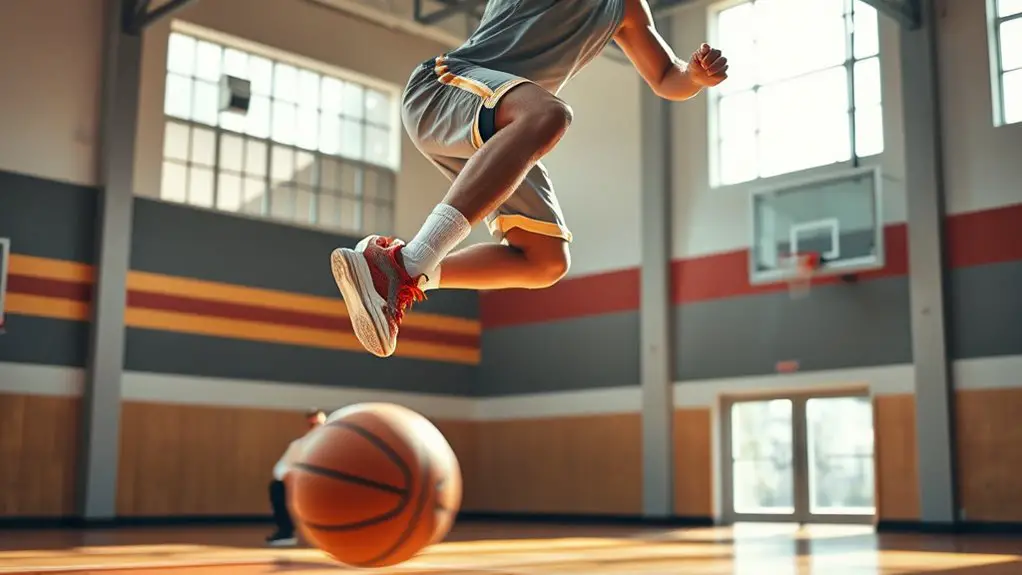
To train for explosive power as a basketball player, focus on exercises that engage fast-twitch muscle fibers. Incorporate Olympic lifts, heavy squats, and bench presses to build strength. Don’t overlook plyometrics—box jumps and depth jumps can greatly improve your vertical leap. Speed and agility drills, like sprints and quick directional changes, will enhance your game pace. Remember, nutrition and recovery are essential. Stick with it, and you’ll discover even more ways to elevate your performance.
Understanding Explosive Power in Basketball
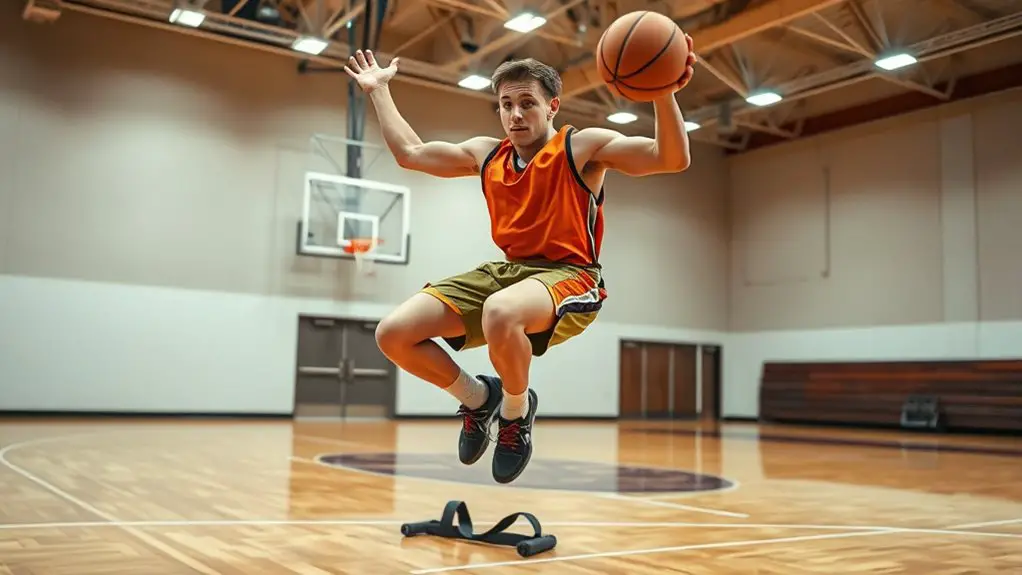
When you step onto the court, understanding explosive power is fundamental for elevating your game. This power is the ability to perform explosive movements—quick, forceful actions that can change the pace of a game. It’s not just about strength; it’s about how efficiently you can recruit muscle fiber, especially fast-twitch fibers, which are essential to generating that explosive energy. Fast-twitch fibers are the muscle fibers that ignite during high-intensity bursts, like sprinting or jumping.
To excel in basketball, you need to harness these fibers through specific training and conditioning. This means focusing on drills that mimic game scenarios where speed and power are critical. As you develop your explosive power, you’ll find yourself soaring higher for rebounds, sprinting past defenders, and executing plays with precision. So, commit to understanding this pivotal component of your game, and watch how it transforms your performance on the court.
Key Exercises to Develop Explosive Strength
To develop explosive strength for basketball, you need to incorporate specific exercises that target your fast-twitch muscle fibers and enhance your overall power output. Start with Olympic lifts like the clean and jerk or snatch. These compound movements demand coordination and engage multiple muscle groups, making them excellent for building strength and explosive power.
Next, add heavy squats and deadlifts to your strength training routine. Focus on low-rep, high-weight sets to maximize your strength gains. Incorporating bench presses can also improve your upper body explosiveness, which is crucial for shooting and passing.
Don’t overlook the importance of medicine ball throws and kettlebell swings. These explosive movements help improve your reaction time and overall athleticism. By focusing on these key exercises, you’re not just training for strength; you’re preparing your body to release explosive power on the court. Stay consistent, and you’ll see results.
Plyometrics: The Secret to Jump Higher
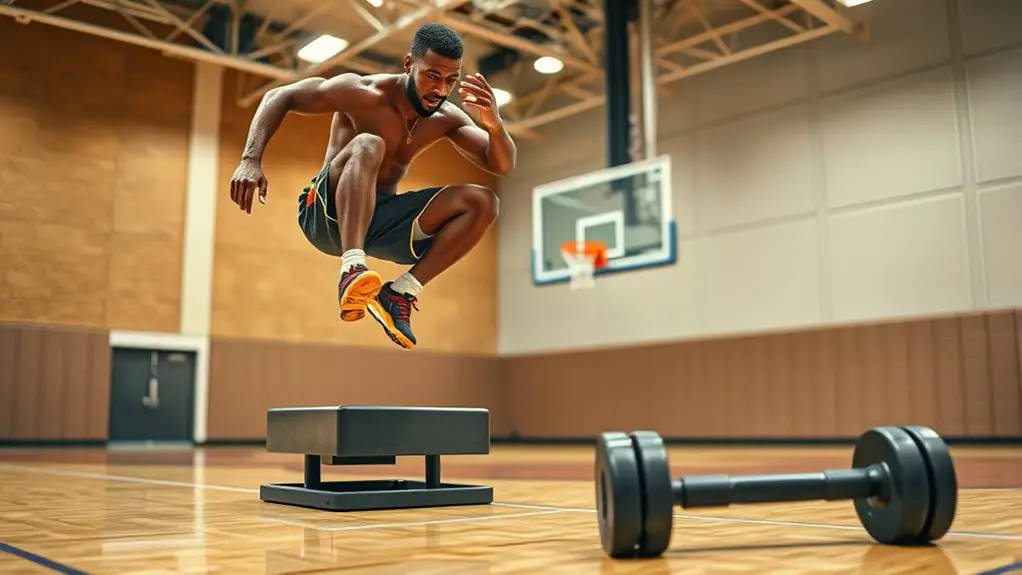
Incorporating plyometrics into your training regimen can dramatically enhance your vertical leap, giving you the edge you need on the basketball court. Plyometric exercises focus on explosive techniques that improve your jump mechanics, enabling you to convert strength into speed and height more effectively.
Start with fundamental movements like box jumps and depth jumps, which train your fast-twitch muscle fibers. These explosive exercises not only maximize your power output but also enhance your neuromuscular coordination.
As you progress, incorporate advanced drills such as single-leg hops and plyometric push-ups to challenge balance and stability, crucial for maintaining control during gameplay. Remember, consistency is key; aim for 2-3 plyometric sessions per week.
Incorporating Speed and Agility Drills
While many players focus solely on strength training and plyometrics, integrating speed and agility drills into your regimen is crucial for achieving explosive power on the court. Speed drills, like sprints and shuttle runs, enhance your quickness, allowing you to beat defenders and excel in fast breaks. Incorporating agility cones into your practice can considerably improve your footwork and change of direction, key elements for evading opponents and creating scoring opportunities.
Set up a series of agility cones and practice lateral movements, zig-zags, and 360-degree turns to sharpen your responsiveness. Combine these drills with game-like scenarios, simulating actual plays to make certain your training translates effectively to the court. Remember, it’s not just about speed; it’s about how quickly you can react and adjust under pressure. Commit to these drills, and you’ll notice a marked improvement in your overall performance, contributing to your explosive power and on-court dominance.
Nutrition and Recovery for Optimal Performance

Nutrition and recovery play a pivotal role in maximizing your explosive power on the basketball court. To perform at your best, focus on meal timing and hydration strategies. Consuming the right nutrients at ideal times can greatly enhance your performance.
Here’s a quick reference table to guide your nutrition and recovery:
| Time Frame | Recommended Foods | Hydration Strategies |
|---|---|---|
| Pre-Workout (1-2 hrs) | Lean protein, complex carbs | 500-700 ml water |
| Post-Workout (30 mins) | Protein shake, fruits | Electrolyte drink |
| Throughout Day | Whole grains, veggies | 2-3 liters of water |
| Evening Recovery | Lean meats, healthy fats | Herbal teas or water |
| Sleep Preparation | Light protein, carbs | Avoid caffeine, hydrate well |
Implement these strategies, and you’ll see improvements in your explosive power and overall performance.
Frequently Asked Questions
How Often Should I Train for Explosive Power Each Week?
When it comes to training frequency, you should aim for about 2 to 3 sessions per week focused on explosive power. This allows you to maximize gains while ensuring adequate recovery. Remember, recovery’s just as important as the training itself; it helps your muscles rebuild and grow stronger. Listen to your body, and don’t hesitate to adjust your schedule if you’re feeling fatigued. Consistency is key, but balance is essential for long-term progress.
Can Yoga Help Improve My Explosive Power?
Yes, yoga can definitely help improve your explosive power. By enhancing flexibility and balance, yoga benefits your overall athletic performance. It aids in muscle recovery, reduces injury risk, and increases body awareness, which are essential for explosive movements. Incorporating yoga into your routine can complement your training, allowing you to engage your core more effectively and execute powerful jumps and sprints. So, don’t underestimate the impact of a solid yoga practice on your explosive performance!
What Is the Best Age to Start Training Explosively?
Imagine a seed sprouting in fertile soil—youth training begins around ages 8 to 12. At this age, your body’s like a sponge, soaking up skills and strength. Age factors play an essential role; starting early lets you harness explosive power while avoiding injury later. As you grow, your training can evolve, ensuring you’re not just leaping but soaring. So, don’t hesitate—embrace the journey and watch yourself take flight!
Are There Specific Warm-Up Routines for Explosive Training?
Yes, there are specific warm-up routines tailored for explosive training. You should start with dynamic stretching to enhance flexibility and prepare your muscles. Incorporate plyometric drills, like jumping jacks or box jumps, to activate fast-twitch muscle fibers. This combination not only boosts your performance but also minimizes injury risks. Remember, a proper warm-up is essential; it sets the tone for an effective training session and primes your body for explosive movements.
How Do I Track My Progress in Explosive Power Training?
You might think tracking progress isn’t necessary, but it’s essential for improvement. Start by establishing clear progress metrics, like jump height or sprint times. Use training logs to document your workouts and results consistently. This’ll help you identify what works and where you need to adjust. Celebrate small victories along the way; they’ll keep you motivated. Remember, progress isn’t just about numbers—it’s about becoming the athlete you aspire to be.



